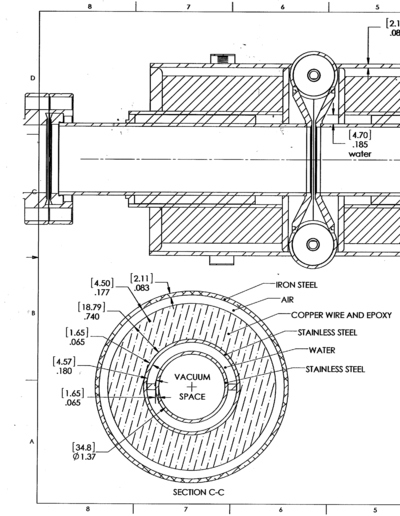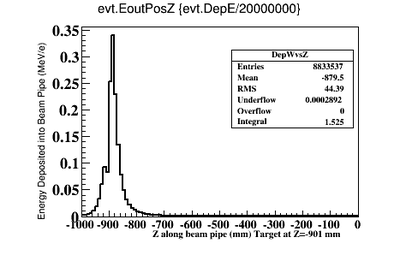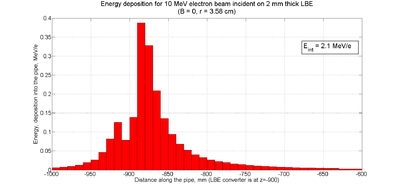Difference between revisions of "Niowave 11-2015"
(Created page with "The energy deposited by electrons scattered into a 3.48 diameter stainless steel beam pipe (1.65 mm thick) from a PbBi target as a function of a uniform Solenoidal magnetic fiel…") |
|||
| (17 intermediate revisions by the same user not shown) | |||
| Line 1: | Line 1: | ||
| − | The | + | Niowave Positron Project Progress for November 2015 |
| + | |||
| + | |||
| + | The next step in the positron project, after determining the PbBi thickness for maximum positron production, was to estimate the heat that would be deposited from the primary electron beam on the beam pipe. Electrons scattered by the PbBi target will intersect a beam pipe used to transport the desired positrons. Electrons traversing the beam pipe can deposit energy that will heat the beam pipe. The goal of this simulation was to estimate the amount of the deposited energy to determine if there is sufficient cooling to prevent a beam pipe breach. Below is a preliminary design of the beam pipe dimensions. | ||
| + | |||
| − | |||
{| border="1" | {| border="1" | ||
| − | |||
| − | |||
|- | |- | ||
| − | | | + | [[File:TF_Niowave_SolenoidDesign_9-3-15.png | 400 px]] |
| − | |- | + | |- |
| − | | | + | |Element || dimension |
| − | |- | + | |- |
| − | | | + | | Inner beam pipe radius || 1.74 cm |
| − | |- | + | |- |
| − | | | + | | Inner beam pipe thickness || 0.165 cm |
| − | |- | + | |- |
| − | | | + | |water jacket thickness || 0.457 cm |
| − | |- | + | |- |
| − | | | + | | outer beam pipe radius || 2.362 cm |
| − | | | + | |- |
| + | | outer beam pipe thickness || 0.165 cm | ||
| + | |- | ||
| + | | Solenoid inner radius || 2.527 cm | ||
| + | |- | ||
| + | | Solenoid outer radius || 4.406 cm | ||
|} | |} | ||
| − | + | A comparison between the prediction from MCNPX and GEANT4 was once again performed. | |
| − | + | A 10 MeV electron beam with a radius of 0.5 cm was incident on a 2 mm thick PbBi target. The target is positioned at Z = -902 mm. | |
| − | + | As shown in the figure below, GEANT4 predicts a peak energy deposition of 0.35 MeV/e while MCNPX predicts about 0.38 MeV/e. GEANT4 predicts a total of <math>3.08\times 10^7</math> MeV (the integral adds up the energy in each 1cm bin) of energy will be deposited in | |
| − | A | + | a 1m long beam pipe surrounding a 2 mm thick PbBi target located at Z=-902 mm when 20 million electrons impinge the target. The next step is to repeat his calculation in the presence of a solenoid surrounding the target. |
| − | |||
| − | |||
| − | |||
| − | |||
| − | |||
| − | |||
| − | |||
| − | |||
| − | |||
| − | |||
| − | |||
| − | |||
| − | <math> | ||
| − | |||
| − | |||
| − | |||
| − | |||
| − | |||
{| border="1" | {| border="1" | ||
| − | | [[File: | + | | [[File:BeamPipeDepEmev_34.8_082915.png |400px]] || [[File:MCNPXBeamPipeDepEmev_34.8_090315.png |400px]] |
| − | |+ Energy deposited (MeV) | + | |+ Energy deposited (MeV) in a 1 m long 3.48 cm diameter beam pipe surrounding a 2 mm target located at Z=-900 mm. |
|} | |} | ||
| − | |||
| − | |||
| − | |||
Latest revision as of 15:20, 13 April 2016
Niowave Positron Project Progress for November 2015
The next step in the positron project, after determining the PbBi thickness for maximum positron production, was to estimate the heat that would be deposited from the primary electron beam on the beam pipe. Electrons scattered by the PbBi target will intersect a beam pipe used to transport the desired positrons. Electrons traversing the beam pipe can deposit energy that will heat the beam pipe. The goal of this simulation was to estimate the amount of the deposited energy to determine if there is sufficient cooling to prevent a beam pipe breach. Below is a preliminary design of the beam pipe dimensions.

| Element | dimension |
| Inner beam pipe radius | 1.74 cm |
| Inner beam pipe thickness | 0.165 cm |
| water jacket thickness | 0.457 cm |
| outer beam pipe radius | 2.362 cm |
| outer beam pipe thickness | 0.165 cm |
| Solenoid inner radius | 2.527 cm |
| Solenoid outer radius | 4.406 cm |
A comparison between the prediction from MCNPX and GEANT4 was once again performed. A 10 MeV electron beam with a radius of 0.5 cm was incident on a 2 mm thick PbBi target. The target is positioned at Z = -902 mm. As shown in the figure below, GEANT4 predicts a peak energy deposition of 0.35 MeV/e while MCNPX predicts about 0.38 MeV/e. GEANT4 predicts a total of MeV (the integral adds up the energy in each 1cm bin) of energy will be deposited in a 1m long beam pipe surrounding a 2 mm thick PbBi target located at Z=-902 mm when 20 million electrons impinge the target. The next step is to repeat his calculation in the presence of a solenoid surrounding the target.
 |

|